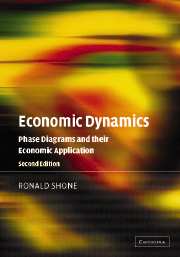Book contents
- Frontmatter
- Contents
- Preface to the second edition
- Preface to the first edition
- PART I Dynamic modelling
- PART II Applied economic dynamics
- 8 Demand and supply models
- 9 Dynamic theory of oligopoly
- 10 Closed economy dynamics
- 11 The dynamics of inflation and unemployment
- 12 Open economy dynamics: sticky price models
- 13 Open economy dynamics: flexible price models
- 14 Population models
- 15 The dynamics of fisheries
- Answers to selected exercises
- Bibliography
- Author index
- Subject index
12 - Open economy dynamics: sticky price models
Published online by Cambridge University Press: 05 June 2012
- Frontmatter
- Contents
- Preface to the second edition
- Preface to the first edition
- PART I Dynamic modelling
- PART II Applied economic dynamics
- 8 Demand and supply models
- 9 Dynamic theory of oligopoly
- 10 Closed economy dynamics
- 11 The dynamics of inflation and unemployment
- 12 Open economy dynamics: sticky price models
- 13 Open economy dynamics: flexible price models
- 14 Population models
- 15 The dynamics of fisheries
- Answers to selected exercises
- Bibliography
- Author index
- Subject index
Summary
In this chapter and chapter 13 we shall consider a number of open economy models that exhibit dynamic behaviour. We shall start with the very simplest – the income–expenditure model considered at the beginning of all courses on macroeconomics. This model assumes a fixed exchange rate. Simple as it is, it will allow us to set the scene and illustrate, in the simplest possible terms, how instability may occur, but is less likely to occur in an open economy in comparison to a closed one. We then do the same in the context of the IS-LM model we discussed in chapter 10, extending it to the open economy, but considering the situation under both a fixed and a flexible exchange rate. This forms the basis of the Mundell–Fleming model. This model was originally concerned with the relative impact of monetary and fiscal policy under fixed and floating exchange rate regimes, but with perfect capital mobility. It has become the standard model of open economy macroeconomics, and so we shall look into its dynamic properties in some detail – for models with some (but not perfect) capital mobility and for situations of perfect capital mobility. We shall find that the assumption about the degree of capital mobility is quite important to the dynamic results. As in earlier chapters, we shall be particularly interested in what happens out of equilibrium, and hence in the dynamic forces in operation in an open economy.
- Type
- Chapter
- Information
- Economic DynamicsPhase Diagrams and their Economic Application, pp. 519 - 552Publisher: Cambridge University PressPrint publication year: 2002



